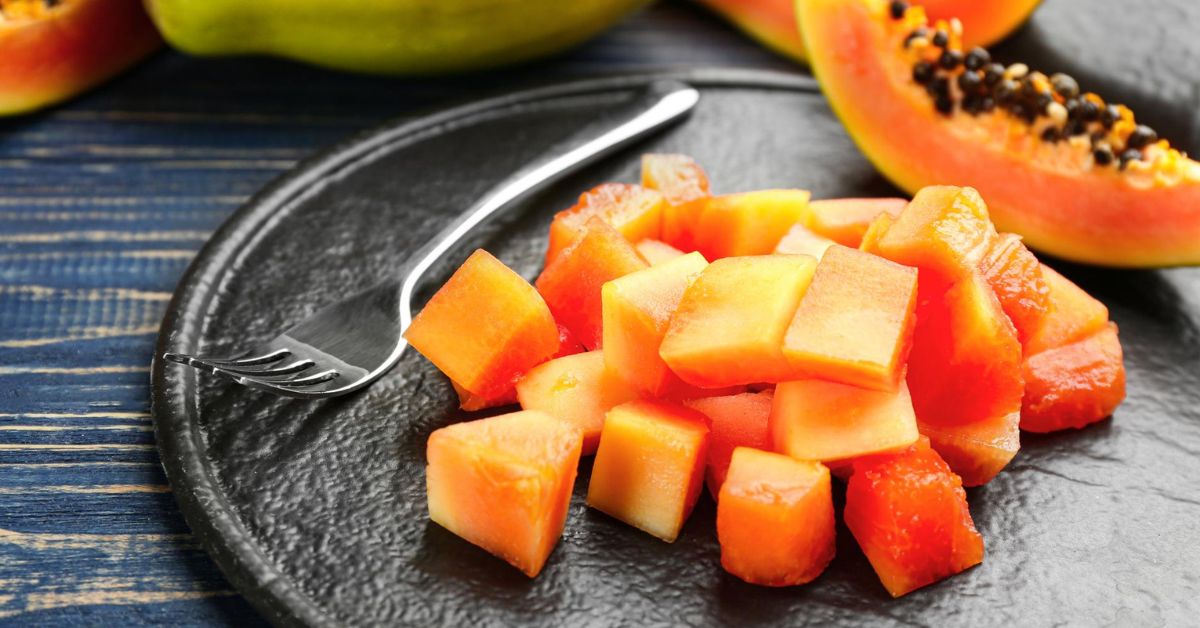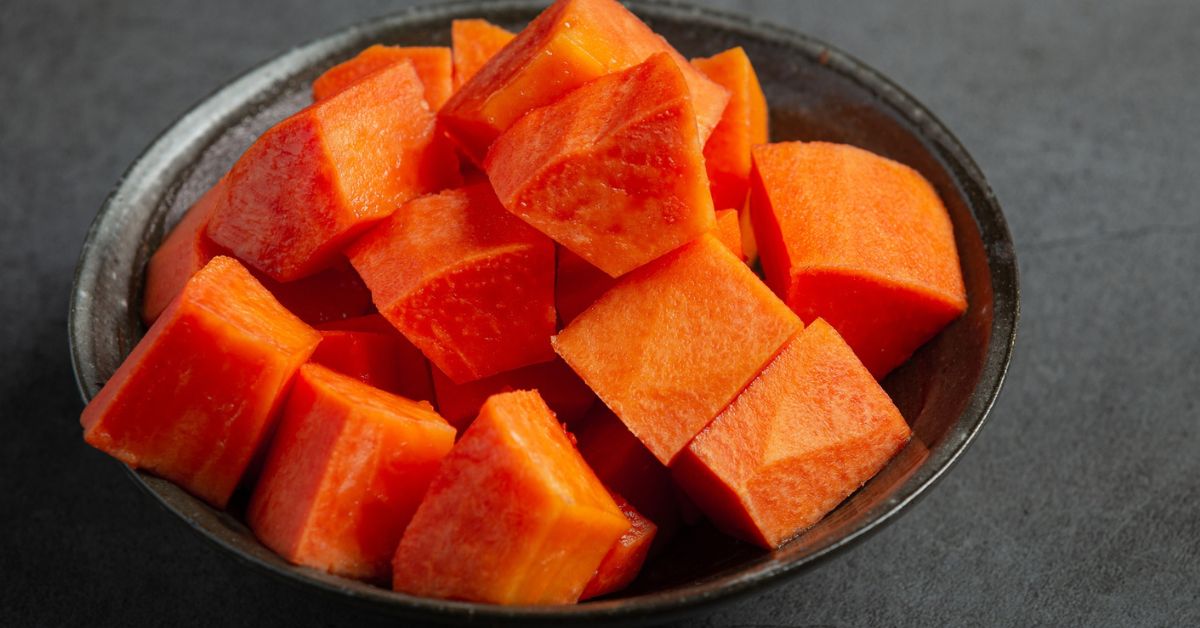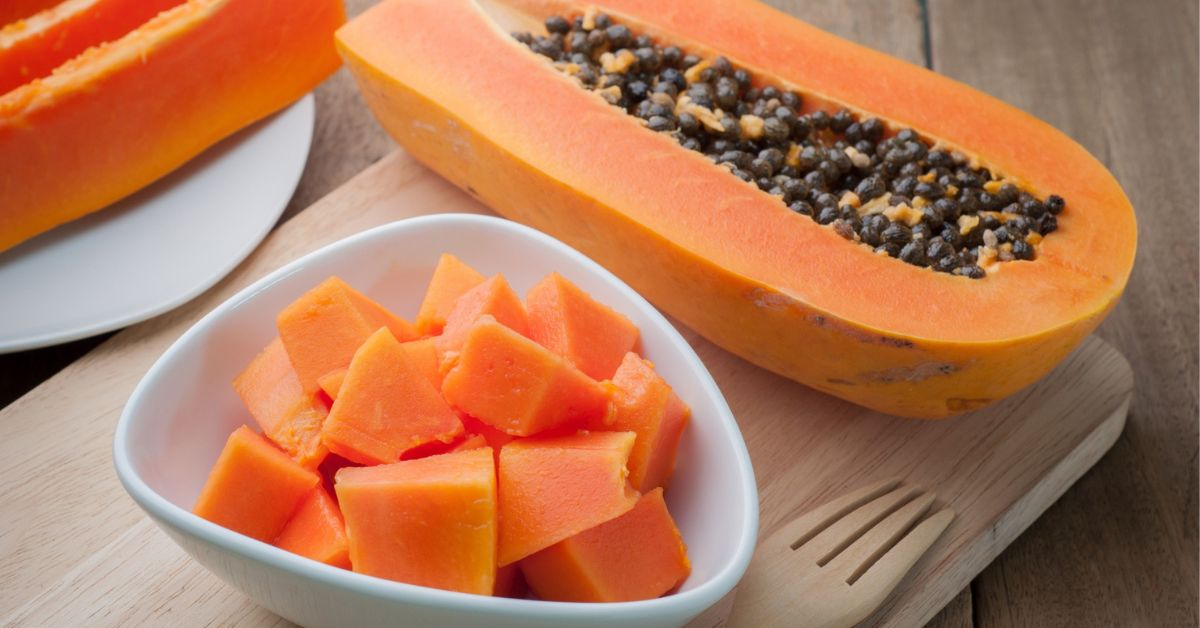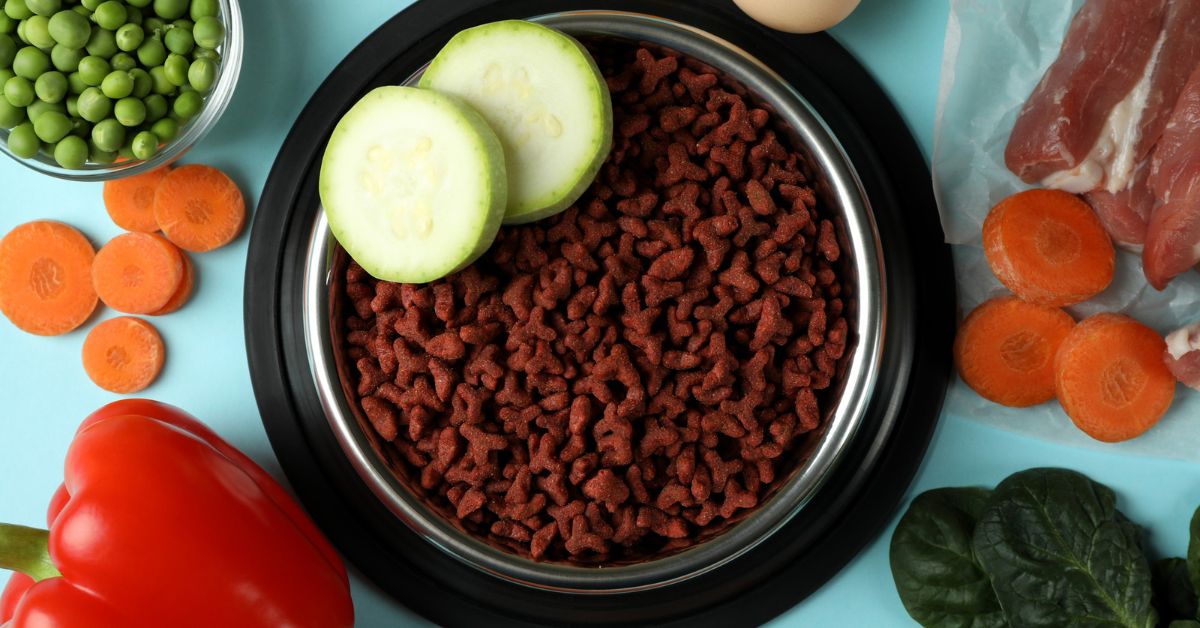Many people enjoy papayas for their sweet taste and numerous health benefits. But as a dog owner, you might wonder, “Can dogs eat papaya?” Yes, dogs can eat papaya, but there are important details to consider to keep your pet safe and healthy.
In this article, we will explore the nutritional benefits of papaya for dogs, how to safely prepare and serve it, and the risks you should be aware of. With these key points in mind, you can make an informed decision about including papaya in your dog’s diet. Let’s dive in.
Is Papaya Safe for Dogs?
Yes, papaya is safe for dogs. However, there are a few precautions to consider. Always remove the seeds before serving. Papaya seeds can be harmful if ingested. They contain small amounts of cyanide and can cause intestinal blockage.
Additionally, remove the skin. The skin can be tough to digest and may cause stomach upset. Serve papaya in small, bite-sized pieces. It prevents choking and ensures easy digestion.
Introduce papaya gradually. Watch for any allergic reactions or digestive issues. Signs of an allergic reaction include itching, swelling, or difficulty breathing. If you notice any of these, stop feeding papaya and consult your vet.
Papaya should be an occasional treat, not a regular part of your dog’s diet. Too much fruit can lead to weight gain and digestive problems. Moderation is key to ensuring your dog’s health and well-being.
Nutritional Benefits of Papaya for Dogs

Papaya is rich in vitamins and minerals. It contains vitamins A, C, E, and K, which support your dog’s overall health.
- Vitamin A promotes healthy vision and skin
- Vitamin C boosts the immune system and reduces inflammation
- Vitamin E acts as an antioxidant, protecting cells from damage
- Vitamin K helps with blood clotting and bone health
Papaya is also a good source of fiber. Fiber aids in digestion and helps prevent constipation. It can improve your dog’s digestive health. The fruit also contains folate, potassium, and calcium. Folate supports cell growth and metabolism. Potassium helps maintain proper heart and muscle function. Calcium is essential for strong bones and teeth.
Papaya contains enzymes like papain. Papain aids in protein digestion, making it easier for your dog to absorb nutrients. It can be especially beneficial for dogs with digestive issues.
Papaya offers unique benefits compared to other fruits. For example, apples and blueberries are also healthy, but they lack papain. Incorporating a variety of fruits can provide a balanced diet.
Overall, papaya can be a nutritious addition to your dog’s diet. However, it should be given in moderation. Too much fruit can lead to digestive issues.
Can Dogs Eat Papaya Seeds?
No, dogs should not eat papaya seeds. Papaya seeds contain small amounts of cyanide, which can be harmful in large quantities. While one or two seeds may not cause immediate harm, it’s best to avoid them altogether. Seeds can also pose a choking hazard.
If ingested in larger amounts, they can block your dog’s intestines. Always remove the seeds before offering papaya to your dog. Focus on the flesh of the fruit, which provides beneficial nutrients. Ensuring your dog’s safety is crucial when introducing new foods. When in doubt, consult your veterinarian for advice.
Can Dogs Eat Papaya Skin?
No, dogs should not eat papaya skin. The skin is difficult for dogs to digest, and it can cause gastrointestinal upset and blockages in the digestive tract. Always remove the skin before serving papaya to your dog. Ensure that the fruit’s flesh is soft and ripe.
The flesh contains beneficial nutrients that support your dog’s health. Moderation is key when introducing any new food. Always consult your veterinarian if you have concerns about your dog’s diet. Ensuring your dog’s safety and well-being should always come first.
Can Dogs Eat Dried Papaya?
Dogs can eat dried papaya, but with caution. Dried papaya often contains added sugars or preservatives. These additives can be harmful to dogs in large amounts. Always check the ingredient list before offering dried papaya. Opt for unsweetened, dehydrated papaya without additives when possible.
Serve dried papaya in moderation. Dried fruits contain more sugars and calories, and too much can lead to weight gain or digestive issues. Always chop it into small pieces to prevent choking. As with any new treat, monitor your dog for any adverse reactions. Consulting your veterinarian is advisable for dietary concerns.
Can Dogs Eat Cooked Green Papaya?
Yes, dogs can eat cooked green papaya in moderation. Cooking can make the papaya easier for some dogs to digest. However, avoid adding any seasonings, oils, or spices. These additives can be harmful to dogs.
Green papaya contains beneficial nutrients, including vitamins and enzymes. It can support digestive health and provide essential nutrients. Always chop the cooked papaya into small, manageable pieces for your dog. Introduce it gradually to monitor for any adverse reactions.
Can Dogs Eat Raw Papaya?
Yes, dogs can eat raw papaya, and it can be a healthy treat. Raw papaya is rich in vitamins and enzymes that are beneficial for your dog’s health. It supports digestion and provides antioxidants.
Always remove the seeds and skin before serving. The skin is tough, while the seeds can be harmful if ingested. Cut the ripe flesh into small, bite-sized pieces to prevent choking.
Introduce raw papaya gradually to ensure your dog tolerates it well. Monitor for any signs of allergies or digestive upset. As with any new food, consult your veterinarian for personalized dietary advice.
Can Dogs Eat Papaya If They Have Already Tried Guava?
If a dog has already tried guava, pet owners may wonder, “can guava be safe for dogs?” While guava can be safe in moderation, introducing papaya is also beneficial. Rich in vitamins and fiber, papaya can aid digestion and provide a tasty treat, complementing a dog’s dietary variety.
How to Serve Papaya to Dogs

Serving papaya to your dog can be a healthy and enjoyable treat when done correctly. Follow these steps to prepare and serve papaya safely:
- Select ripe papaya: Look for yellow skin with a slight give when pressed.
- Wash thoroughly: Remove any pesticides or dirt from the surface.
- Cut in half: Use a knife to slice the papaya into two halves.
- Scoop out seeds: Remove and discard the seeds to prevent any health risks.
- Peel the skin: Take off the tough, indigestible skin.
- Cut into small pieces: Slice the flesh into bite-sized pieces to avoid choking.
- Serve as a treat: Offer the papaya pieces directly to your dog.
- Mix with regular food: Add the pieces to your dog’s regular meal for variety.
- Start with small amounts: Introduce papaya gradually and monitor for any adverse reactions.
- Serve occasionally: Give papaya as an occasional treat, not a daily diet staple.
- Consult your vet: Always get personalized advice before introducing new foods.
Potential Risks and Precautions
While papaya is generally safe, there are potential risks. Overfeeding can cause digestive issues, and too much fiber may lead to diarrhea or stomach upset.
Always remove seeds and skin. Seeds contain small amounts of cyanide, which can be harmful. The skin is tough and can cause digestive problems.
Watch for allergic reactions. Symptoms include itching, swelling, and difficulty breathing. If any of these occur, stop feeding papaya immediately. Consult your vet if you notice adverse reactions.
Serve papaya in moderation. It should be an occasional treat, not a regular diet item. Too much fruit can lead to weight gain and other health issues.
Consult your vet before introducing papaya. They can provide personalized advice based on your dog’s health. Always prioritize your dog’s well-being.
Read More: Can Dogs Eat Eggshells?
Final Words
To conclude, the answer to the question, “Can dogs eat papaya?” is yes, with certain precautions. This nutritious fruit can be a healthy addition to your dog’s diet when served correctly. Remove the seeds and skin, and introduce it gradually to monitor for any adverse reactions.
Remember to serve papaya in moderation to maintain your dog’s digestive health. If you have any concerns, consult your veterinarian to ensure the best dietary choices for your furry friend.




